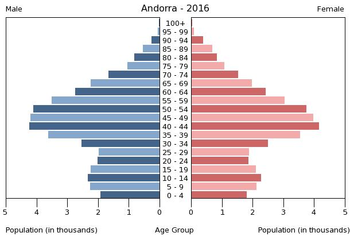Our website is made possible by displaying online advertisements to our visitors.
Please consider supporting us by disabling your ad blocker.
Demographics of Andorra
This article needs additional citations for verification. (March 2024) |
| Demographics of Andorra | |
|---|---|
 Population pyramid of Andorra in 2016 | |
| Population | 85,560 (2022 est.) |
| Growth rate | -0.1% (2022 est.) |
| Birth rate | 6.2 births/1,000 population (2022) |
| Death rate | 4.5 deaths/1,000 population (2022) |
| Life expectancy | 83.42 years |
| • male | 81.2 years |
| • female | 85.79 years |
| Fertility rate | 0.94 children born/woman (2022) |
| Infant mortality rate | 3.44 deaths/1,000 live births |
| Net migration rate | 0 migrant(s)/1,000 population (2022 est.) |
| Age structure | |
| 0–14 years | 13.37% |
| 65 and over | 17.36% |
| Sex ratio | |
| Total | 1.05 male(s)/female (2022 est.) |
| At birth | 1.07 male(s)/female |
| Under 15 | 1.06 male(s)/female |
| 65 and over | 0.9 male(s)/female |
| Nationality | |
| Nationality | Andorran |
| Language | |
| Official | Catalan |
This is a demography of the population of Andorra, including population density, ethnicity, education level, health of the populace, economic status, religious affiliations and other aspects of the population.
Andorrans (originally of Catalan descent) are a minority in their own country; Spanish, French, and Portuguese residents make up 67.7% of the population.
The national language is Catalan, a Romance language in the Western Romance group. It is spoken by more than 9 million people in the nearby territories of Spain and France. Spanish, French, and Portuguese are also spoken.
Andorrans live in seven urbanized valleys that form Andorra's political districts, the seven parròquies (parishes):
Previous Page Next Page


